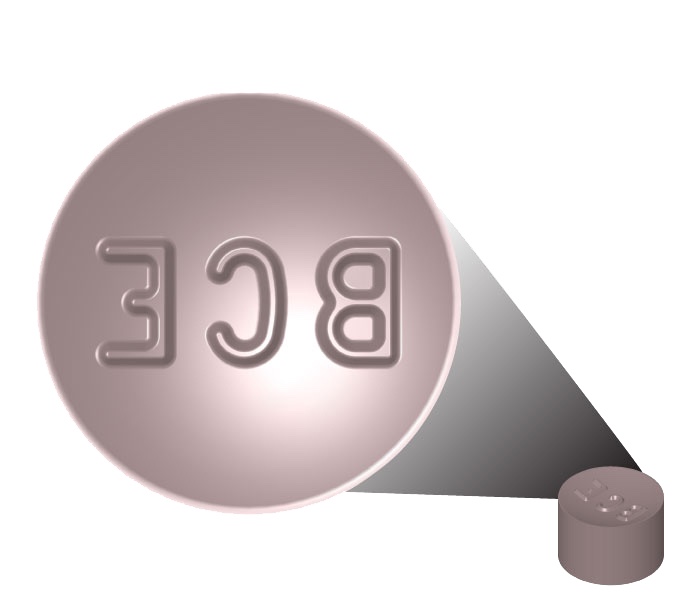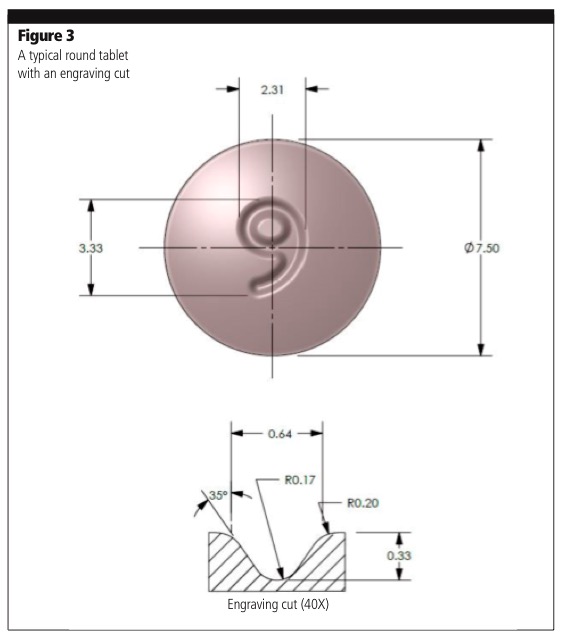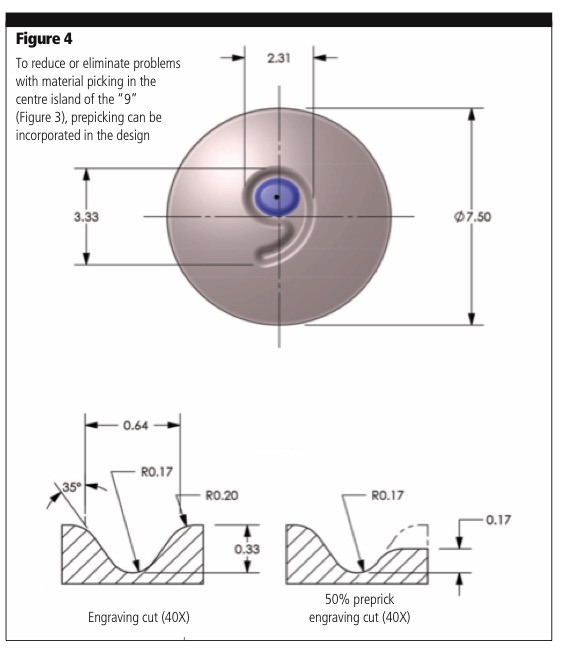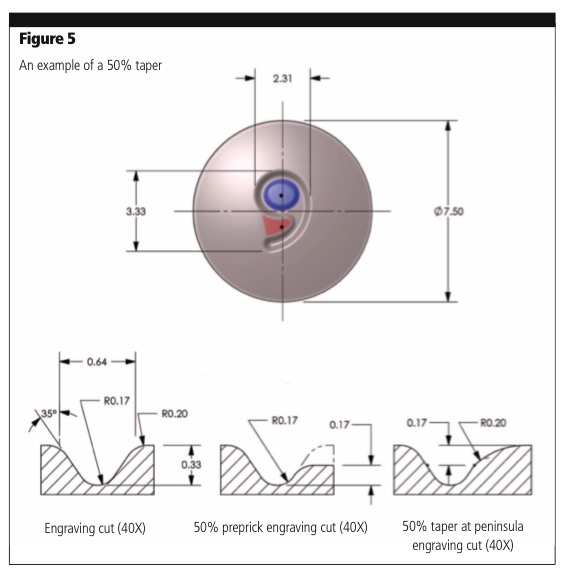Whether pharmaceutical, nutraceutical or confectionery, tablet sticking and picking problems are ubiquitous in the tablet manufacturing industry. Often, in the regulated world of drug-product manufacturing, there is a sense of urgency surrounding the development of new molecule offerings. This urgency can, however, result in hasty decisions being made to enter clinical trials or submit a formulation for regulatory approval, which ultimately results in unanticipated compression scale-up problems. The design process for an oral solid dosage form often overlooks some of the seemingly minor details of tablet design. This can result in tablet defects as the manufacturing process scales-up from clinical to full patient-population supply.
The requirements of a pharmaceutical company’s marketing department for certain tablet shapes and logos to enhance brand recognition are a source of design constraints, often resulting in post-approval manufacturing complications. Compression tooling manufacturers can often identify potential sticking and picking issues before tablet and tooling designs have been finalised, reducing the challenge shared by the tablet manufacturer and the tooling vendor.
Sticking and picking issues generally arise from either formulation or tablet design inadequacies. Both emerge because of the differences in physical properties of the formulation excipients and drug substance. The process of blending the formulation components results in a powder that will either consolidate and compress, or not. As the failure to compress into a tablet is a separate issue, we will only consider powders that will actually compress.
Cohesive forces: forming a solid dose tablet
The formation of a compact is the result of chemical dispersive and mechanical forces joining particles to form a solid of measurable density and porosity. The cohesive forces binding the particles together can be assessed using a series of studies to determine whether problems with tablet compaction can be anticipated.1 Compaction profiles and strain rate studies are important aspects of development projects. These studies ensure that the probability of successful scale-up and technical transfer is high. Therefore, market supply is not impacted because technical due diligence was overlooked.
Tablet particles are bound by cohesive forces. However, during the compression process, the cohesive forces binding the particles are challenged by the adhesive forces of the punch cup and the embossing within the punch cup. The first stage of a sticking problem occurs when the adhesive force of the punch cup can pull even a single particle away from the tablet. A recent publication indicates that this is principally caused by the physical properties of the active pharmaceutical ingredient (API), the mechanism and kinetics of which can be successfully modelled.2
The problem of formulation sticking in the letters and characters of punch embossing is typically referred to as picking. Picking is a type of sticking that’s often rooted in an inferior tablet design. Picking issues can normally be resolved, but are rarely predictable and often not detected until transferring product from the research and development (R&D) environment to the production setting. Among the typical sources of picking issues are the selection of the proper font and the engraving cut design for character islands and character peninsulas.
Simple considerations to alleviate sticking and picking
The remediation of picking and sticking does not always mean changing the tools used for tablet manufacturing. When powder sticks in the embossed letters, one of the first things to check is the moisture level of the formulation. Excess formulation moisture or excessive humidity in the compression suite can initiate picking. Insufficient compression force is also a potential source of picking because powder compaction is not complete. This means that the adhesive forces can readily overcome the cohesive forces of the improperly compressed tablet.
Another potential solution is to increase the amount of lubricant used in the formulation. This will facilitate the release of the compressed tablet from the punch cup surface. Careful inspection of the punch cups is also essential to ensure that there are no surface scratches to capture very small particles of formulation. These scratches will lead to filming, a slow form of sticking, often derived from excess moisture in the granulation. If surface scratches are identified, punches should be polished. A specialised polishing compound can be used to impart greater lubricity and better product release properties as well.
Reducing picking with font selection
When simple fixes, as mentioned above, are not enough, a full tablet and tooling design review may be necessary. Font selection is often a battle of form versus function. An ornate or decorative font, while pleasing to the eye, will likely cause picking problems and tablet defects. Figure 1 illustrates an impractical font selection. The variation in engraving width, as well as the isolated and unnecessary peninsulas of the letters, are impediments to even powder compaction. This variation often leads to powder picking away from the compressed tablet core, thus remaining in the punch cup. Figure 2 illustrates the same embossing using a practical font that utilises increased engraving and corner radii. The font modification minimises picking opportunities, increases the opportunity for consistent powder compaction and yields the best possible cohesive forces for the tablet.

The same embossing as figure 1, but using a practical font
Changing the engraving cut
In addition to changes in font selection, attention should be paid to the design of the engraving cut. Figure 3 illustrates a typical round tablet. The engraving of the “9” cut into the tablet is illustrated with a typical engraving cut width, depth and angle of 35 degrees. Most product formulations should be readily compressed into tablets using tools with this engraving design. However, many formulations are not typical… and problems can still occur.

To reduce or eliminate problems with material picking in the centre island of the “9” (Figure 3), prepicking can be incorporated in the design. This is illustrated in Figure 4 wherein the depth of the island is reduced from 0.33 to 0.17 mm. This reduction is defined as a 50% prepick. The amount of reduction can range from 10–100%, depending on the extent of the picking problem. For branding or aesthetic purposes, consideration must be taken for tablets being coated post-compression, as excessive prepicking will significantly reduce the clarity of the logo. The partial prepick concept is applicable to any letter or numeral with fully enclosed areas called “islands” or “pads.”

Many other somewhat complex characters that do not have fully enclosed areas are also prone to picking. Letters such as E, S, K and M, and numerals such as 2, 3 and 5 all contain these partially enclosed areas that are described as peninsulas. For these areas, we employ a feature called “tapering” or “ramping” to prevent picking. Starting on the tablet surface at the open end of the peninsula, this feature tapers downwards, toward the enclosed end of the peninsula by a percentage of the engraving depth. It is usual to have peninsulas tapered from 10–50% of the engraving depth, with 30% being the most common. An example of a 50% taper is illustrated on the right side of Figure 5.

Materials of tooling construction
If the sticking and picking has been discovered during the R&D stage, or if it is time to order the next set of punches for a product with known sticking and picking issues, another consideration is to have the punches made from a specialty steel. It is widely accepted that punch steels with a high concentration of chromium in the alloy chemistry, usually from 16–18%, enhances the release of compressed product. A reputable tool vendor will have multiple grades of high chrome steel available to manufacture the punches from. There are also several other specialty steels available that can enhance the performance and service life of the punches and dies with regard to compressive strength, wear resistance and corrosion resistance.
As an alternative to using a specialty steel, some may choose to have a coating applied to their standard steel punches to enhance the release characteristics of the punch faces. The most common coatings are Hard Chrome (Cr) and Chromium Nitride (CrN). There are several other coatings available as well, depending on the unique characteristics of the blend to be compressed. However, it should be noted that there is the possibility that the thin chrome coating layer may wear off with time, owing to the abrasion of the formulation and polishing. Thus, the better choice may be a high chrome steel, without coating, for a long-term solution.
Discuss these issues with your tooling vendor early in the process to help reduce production issues and additional costs. Your tooling vendor should be able to explain the unique properties and advantages of the various steels and coatings available for your tooling.
In conclusion
Ultimately, there are several remedies to help speed a new drug to market, ranging from slight formulation changes to major tablet design and tooling modifications. When developing a go-to-market strategy, it is often best to consult with your tooling vendor early. Their insights will benefit the final product and assist in creating a tablet that is accepted by both the manufacturer and the end-consumer. Discussing the unique physical properties with your tool vendor during the tablet design phase will often eliminate sticking and picking issues before they occur.
References
- R. Sedlock, “It’s All in the Detail,” European Pharmaceutical Manufacturer 16(2), 16–17 (2016).
- S. Paul, et al., “Mechanism and Kinetics of Punch Sticking of Pharmaceuticals,” J. Pharm. Sci. 106(1), 151–158 (2017).





